中国婚姻文化(上)
- 格式:pptx
- 大小:400.23 KB
- 文档页数:16

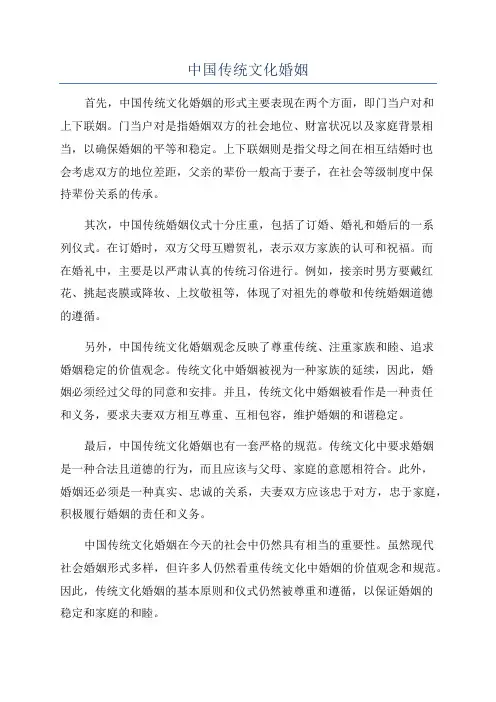
中国传统文化婚姻首先,中国传统文化婚姻的形式主要表现在两个方面,即门当户对和上下联姻。
门当户对是指婚姻双方的社会地位、财富状况以及家庭背景相当,以确保婚姻的平等和稳定。
上下联姻则是指父母之间在相互结婚时也会考虑双方的地位差距,父亲的辈份一般高于妻子,在社会等级制度中保持辈份关系的传承。
其次,中国传统婚姻仪式十分庄重,包括了订婚、婚礼和婚后的一系列仪式。
在订婚时,双方父母互赠贺礼,表示双方家族的认可和祝福。
而在婚礼中,主要是以严肃认真的传统习俗进行。
例如,接亲时男方要戴红花、挑起丧膜或降妆、上坟敬祖等,体现了对祖先的尊敬和传统婚姻道德的遵循。
另外,中国传统文化婚姻观念反映了尊重传统、注重家族和睦、追求婚姻稳定的价值观念。
传统文化中婚姻被视为一种家族的延续,因此,婚姻必须经过父母的同意和安排。
并且,传统文化中婚姻被看作是一种责任和义务,要求夫妻双方相互尊重、互相包容,维护婚姻的和谐稳定。
最后,中国传统文化婚姻也有一套严格的规范。
传统文化中要求婚姻是一种合法且道德的行为,而且应该与父母、家庭的意愿相符合。
此外,婚姻还必须是一种真实、忠诚的关系,夫妻双方应该忠于对方,忠于家庭,积极履行婚姻的责任和义务。
中国传统文化婚姻在今天的社会中仍然具有相当的重要性。
虽然现代社会婚姻形式多样,但许多人仍然看重传统文化中婚姻的价值观念和规范。
因此,传统文化婚姻的基本原则和仪式仍然被尊重和遵循,以保证婚姻的稳定和家庭的和睦。
总结起来,中国传统文化婚姻是中国古代社会中最为重要的社会制度之一,它体现了门当户对、上下联姻的形式,而婚姻仪式庄重且多样,婚姻观念看重家族和婚姻稳定,婚姻规范明确要求尊重和忠诚。
传统文化婚姻在现代社会中仍然具有一定的影响力,它是中国文化传统的重要组成部分,也是保持家庭和社会稳定的重要保障。

论中国古代的婚姻文化中国是一个历史悠久、文化丰富的国家,而婚姻文化是中国文化的重要组成部分之一。
中国古代的婚姻文化与现代的婚姻文化有着很大的不同,这种不同体现了不同的时代背景和文化传承。
本文将从婚姻制度、婚姻习俗、婚姻观念三方面来论述中国古代的婚姻文化。
一、婚姻制度中国古代婚姻制度有明显的父权制特征,男性在婚姻中拥有绝对的优势地位。
在传统的家庭观念中,女性应当服从男性的支配。
因此,在婚姻制度中,女性只有在丈夫和家庭前途上做出最大的牺牲。
除此之外,中国古代还存在着早婚、晚婚以及门当户对等等约束因素。
婚龄、资产、身份等都成为影响婚姻匹配的因素。
在古代,婚姻往往是由父母之间进行商议,女性没有选择自己伴侣的权利。
相亲是传统的婚姻方式,而且是由家人带着介绍人来完成的,女性在婚姻中处于弱势地位,男性则几乎拥有所有权。
这种婚姻制度并不平等,严重影响了妇女的人格尊严和社会地位,同时,也不利于两性平等。
二、婚姻习俗中国的婚姻习俗极为繁多,传统的习俗有“嫁妆”、“梳头”、“入洞房”等等。
其中,“嫁妆”是指女方嫁娶时出的财产或物品,这是家族传承和父母教育女儿的体现。
除此之外,婚礼流程也应有尽有。
“请红娘”是婚礼中的重要一环,红娘一般是媒婆或熟悉家庭情况的人,她在婚礼中起到承上启下的作用。
又如,婚礼上的拜堂、过门、喜酒等细节在传统文化中有着非常重要的意义。
三、婚姻观念中国古代的婚姻观念处于父权制和家族观念的笼罩下。
对于女性来说,婚姻既是一种传宗接代、延续家族的责任,也是女性必须完成的人生使命。
因此,女性在婚姻中的举动必须遵循的是家庭的利益,而不是自己的意愿和个性。
同时,中国古代的婚姻观念也是一种大众意识,作为社会文化的一部分,它也代表着特定的价值和思想观念。
由于这些价值观念的狭隘性,导致了妇女的权利受到严重压迫,且长期受到不平等待遇和歧视。
综上,中国古代的婚姻文化是一个多样性、复杂性的文化现象。
在长期的文化传承过程中,中国古代的婚姻文化不断发展并逐渐形成独特的特点和风格。
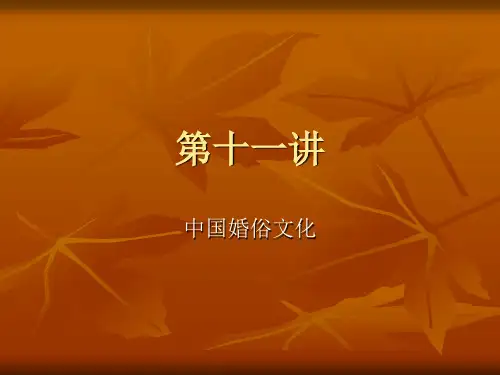
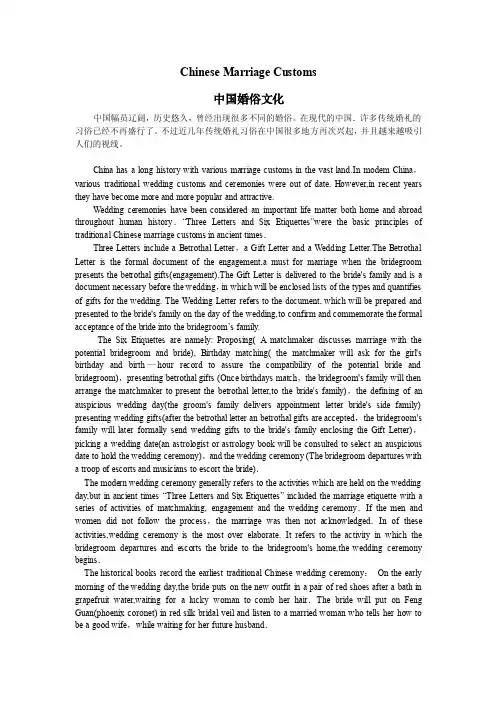
Chinese Marriage Customs中国婚俗文化中国幅员辽阔,历史悠久,曾经出现很多不同的婚俗。
在现代的中国.许多传统婚礼的习俗已经不再盛行了。
不过近几年传统婚礼习俗在中国很多地方再次兴起,并且越来越吸引人们的视线。
China has a long history with various marriage customs in the vast land.In modem China,various traditional wedding customs and ceremonies were out of date. However,in recent years they have become more and more popular and attractive.Wedding ceremonies have been considered an important life matter both home and abroad throughout human history.“Three Letters and Six Etiquettes”were the basic principles of traditional Chinese marriage customs in ancient times.Three Letters include a Betrothal Letter,a Gift Letter and a Wedding Letter.The Betrothal Letter is the formal document of the engagement,a must for marriage when the bridegroom presents the betrothal gifts(engagement).The Gift Letter is delivered to the bride's family and is a document necessary before the wedding,in which will be enclosed lists of the types and quantifies of gifts for the wedding. The Wedding Letter refers to the document, which will be prepared and presented to the bride's family on the day of the wedding,to confirm and commemorate the formal acceptance of the bride into the bridegroom’s family.The Six Etiquettes are namely: Proposing( A matchmaker discusses marriage with the potential bridegroom and bride), Birthday matching( the matchmaker will ask for the girl's birthday and birth—hour record to assure the compatibility of the potential bride and bridegroom),presenting betrothal gifts (Once birthdays match,the bridegroom's family will then arrange the matchmaker to present the betrothal letter,to the bride's family),the defining of an auspicious wedding day(the groom's family delivers appointment letter bride's side family) presenting wedding gifts(after the betrothal letter an betrothal gifts are accepted,the bridegroom's family will later formally send wedding gifts to the bride's family enclosing the Gift Letter),picking a wedding date(an astrologist or astrology book will be consulted to select an auspicious date to hold the wedding ceremony),and the wedding ceremony (The bridegroom departures with a troop of escorts and musicians to escort the bride).The modern wedding ceremony generally refers to the activities which are held on the wedding day,but in ancient times “Three Letters and Six Etiquettes” included the marriage etiquette with a series of activities of matchmaking, engagement and the wedding ceremony.If the men and women did not follow the process,the marriage was then not acknowledged.In of these activities,wedding ceremony is the most over elaborate. It refers to the activity in which the bridegroom departures and escorts the bride to the bridegroom's home,the wedding ceremony begins.The historical books record the earliest traditional Chinese wedding ceremony:On the early morning of the wedding day,the bride puts on the new outfit in a pair of red shoes after a bath in grapefruit water,waiting for a lucky woman to comb her hair.The bride will put on Feng Guan(phoenix coronet) in red silk bridal veil and listen to a married woman who tells her how to be a good wife,while waiting for her future husband.The fun is that when the groom comes to the door of the bride's,the bridesmaids and her sisters try not to let him in!The purpose is to let the bridegroom experience difficulties to enter the door.Usually the groom can overcome the difficulties with his wisdom and courage and the help of hisfriends.Then,the groom sings for the bride and finally he can see the bride,but the groom must offer red packages with money to the bridesmaids and the sisters to be allowed to take his bride home.The bride is accompanied into the sedan by a lucky woman.The bride's sister support a red umbrella,while another sprinkles some rice in the sedan with a metal mirror hanging behind.which people think it can protect the bride from evil spirits.The bride must cry while departing,showing her unwillingness to leave her parents.People began to set off firecrackers to ward off evil spirits while the bride sitting into the sedan.And people will try to avoid unlucky things all the way:the curtain of the sedan was closely plastered in case the bride may see widows, well,cats which are considered as unlucky things.Firecrackers meet the bridegroom's team,the bride will walk a red cushion and pass a burning pan to yard off evil spirits before entering the groom's.The wedding ceremony is the climax of the whole process.The bride and groom are shown into the ancestral temple.They first worship the heaven and earth,the ancestors and parents and then themselves,finally they enter the bridal chamber.An emcee narrates the story,accompanied by the wedding guests with applause and cheers.Friends and guests are entertained at a big wedding banquet.The newlyweds drink the cross-cupped wine,drink to thank the guests and get their blessings.Three days back door practices.Traditionally the newlyweds return to visit the bride's parents in three days.The groom is teased by the bride's relatives and friends out of kindness,of course.As time goes on,the traditional ceremony based on “Three Letters and Six Etiquettes”is gradually simplified.But wedding ceremony is completely passed down.Of course some fashions are melted into the tradition.Sedan chair,for instance,is replaced by heavily flower—decorated car to greet the bride.Nowadays in modem China,traditional wedding ceremonies seem not so popular though still in fashion in the countryside.But people have become more and more interested in it and are paying much attention to traditional wedding ceremonies in recent times.段落译文在人类历史中婚礼仪式被世界公认为是一件重大事情。

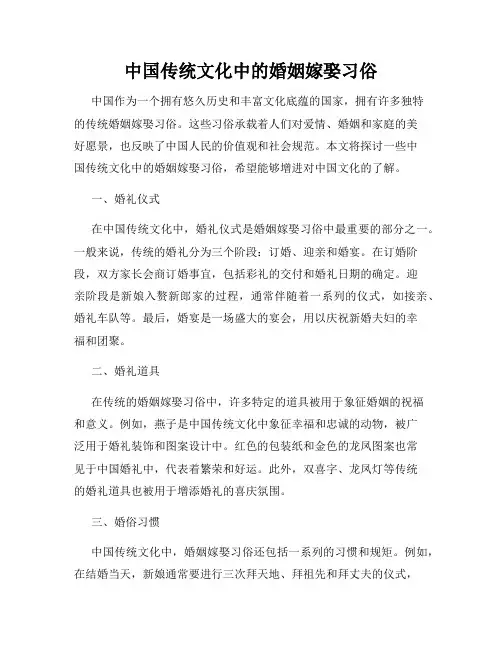
中国传统文化中的婚姻嫁娶习俗中国作为一个拥有悠久历史和丰富文化底蕴的国家,拥有许多独特的传统婚姻嫁娶习俗。
这些习俗承载着人们对爱情、婚姻和家庭的美好愿景,也反映了中国人民的价值观和社会规范。
本文将探讨一些中国传统文化中的婚姻嫁娶习俗,希望能够增进对中国文化的了解。
一、婚礼仪式在中国传统文化中,婚礼仪式是婚姻嫁娶习俗中最重要的部分之一。
一般来说,传统的婚礼分为三个阶段:订婚、迎亲和婚宴。
在订婚阶段,双方家长会商订婚事宜,包括彩礼的交付和婚礼日期的确定。
迎亲阶段是新娘入赘新郎家的过程,通常伴随着一系列的仪式,如接亲、婚礼车队等。
最后,婚宴是一场盛大的宴会,用以庆祝新婚夫妇的幸福和团聚。
二、婚礼道具在传统的婚姻嫁娶习俗中,许多特定的道具被用于象征婚姻的祝福和意义。
例如,燕子是中国传统文化中象征幸福和忠诚的动物,被广泛用于婚礼装饰和图案设计中。
红色的包装纸和金色的龙凤图案也常见于中国婚礼中,代表着繁荣和好运。
此外,双喜字、龙凤灯等传统的婚礼道具也被用于增添婚礼的喜庆氛围。
三、婚俗习惯中国传统文化中,婚姻嫁娶习俗还包括一系列的习惯和规矩。
例如,在结婚当天,新娘通常要进行三次拜天地、拜祖先和拜丈夫的仪式,以示对先人和丈夫的尊敬。
新娘还会在婚礼中穿着华丽的婚纱和戴上配饰,象征着美丽和幸福。
四、传统婚礼饮食婚礼中的饮食习俗也是中国传统文化中婚姻嫁娶的重要组成部分。
例如,喜酒是中国婚礼中不可或缺的一道菜品,象征着新婚夫妇的喜悦和幸福。
在一些地区,送餐的菜肴数量也有特定的讲究,如必须送满"六六大顺"(顺利顺利)或"九九如意"(如意如意),以取吉利的寓意。
此外,一些地区也有特定的婚礼过程中要吃的特殊食品,如在湖南地区,新娘婚礼前要吃辣椒酱,以展示勇气和坚韧。
五、新婚夫妇的住房在中国传统文化中,新婚夫妇的住房也具有特殊的意义。
一般来说,新婚夫妇会选择一个新的居所,以开始他们的婚姻生活。
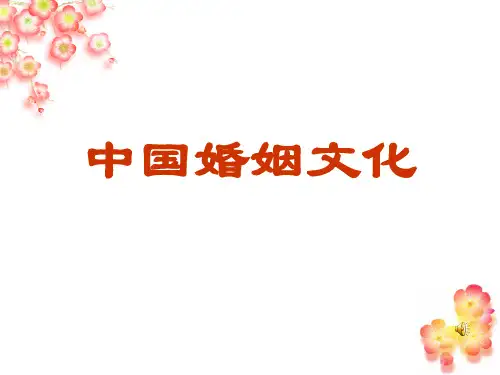
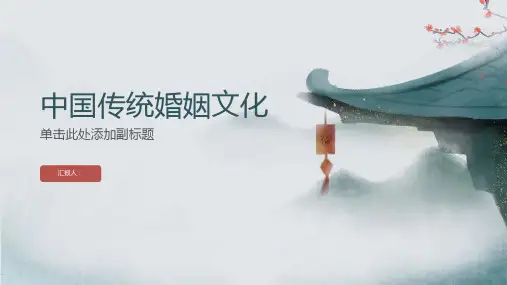

中国婚姻文化婚姻是人类社会的基石,每个国家的婚姻文化都有其独特的特点。
中国作为一个历史悠久的国家,拥有丰富多彩的婚姻文化。
本文将从传统婚礼、婚姻观念、婚礼习俗以及现代婚姻现状等方面,探讨中国婚姻文化的传承与变迁。
传统婚礼中国传统婚礼是中国婚姻文化最重要的组成部分之一。
在古代,婚礼多以“三书六礼”为基本的程序和规范。
其中,“三书”指的是聘礼书、请帖、亲书,代表着男方向女方家庭表示婚姻意愿。
而“六礼”则包括纳采、问名、纳吉、纳征、请期和亲迎,每个环节都有其独特的含义和仪式。
婚姻观念中国传统婚姻观念注重家族延续和血脉传承。
传统婚姻观念将婚姻视为两个家庭的结合,强调家族的连续性和儿孙的繁衍。
尽管如此,随着社会的进步和观念的改变,人们对婚姻观念的理解也有所转变。
如今,婚姻更多地被看作是两个人心灵的契合和互相扶持。
婚礼习俗中国各地的婚礼习俗多种多样,具有鲜明的地域特点。
比如,在北方地区,新娘常会接受新家人的“冷水试”;在南方地区,新娘需要参与门前拜堂等传统仪式。
此外,婚礼中常见的红色装饰、喜糖及喜酒等也是传统婚礼习俗的一部分。
现代婚姻现状如今,中国婚姻文化正在经历着变革。
由于社会发展和人们观念的变化,婚姻的自由选择和平等成为现代婚姻的主题。
相比过去,年轻人更注重婚姻中的感情和精神层面的和谐,婚姻观念也更加多元开放。
此外,随着城市化的进程,婚礼的形式也在不断变化,举办大规模的婚礼酒会已成为一种时尚。
中国婚姻文化的传承与变迁中国婚姻文化的传承与变迁体现了社会的进步和时代的变化。
传统婚礼仪式虽然有所改变,但仍保留了一定的传统元素,以示对传统文化的尊重。
婚姻观念的改变则促进了婚姻关系的平等和民众的幸福感。
婚礼习俗的多样性使得中国的婚礼文化更加丰富多彩。
现代婚姻的发展则反映了人们对婚姻观念和婚礼形式的新认识和需求。
总结中国婚姻文化是一个博大精深的课题,无法在有限的篇幅中全面涵盖。
本文从传统婚礼、婚姻观念、婚礼习俗以及现代婚姻现状等方面,介绍了中国婚姻文化的一些特点。
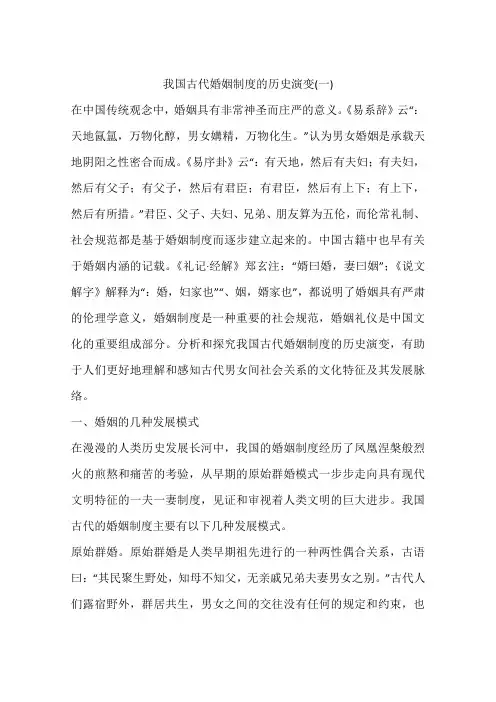
我国古代婚姻制度的历史演变(一)在中国传统观念中,婚姻具有非常神圣而庄严的意义。
《易系辞》云“:天地氤氲,万物化醇,男女媾精,万物化生。
”认为男女婚姻是承载天地阴阳之性密合而成。
《易序卦》云“:有天地,然后有夫妇;有夫妇,然后有父子;有父子,然后有君臣;有君臣,然后有上下;有上下,然后有所措。
”君臣、父子、夫妇、兄弟、朋友算为五伦,而伦常礼制、社会规范都是基于婚姻制度而逐步建立起来的。
中国古籍中也早有关于婚姻内涵的记载。
《礼记·经解》郑玄注:“婿曰婚,妻曰姻”;《说文解字》解释为“:婚,妇家也”“、姻,婿家也”,都说明了婚姻具有严肃的伦理学意义,婚姻制度是一种重要的社会规范,婚姻礼仪是中国文化的重要组成部分。
分析和探究我国古代婚姻制度的历史演变,有助于人们更好地理解和感知古代男女间社会关系的文化特征及其发展脉络。
一、婚姻的几种发展模式在漫漫的人类历史发展长河中,我国的婚姻制度经历了凤凰涅槃般烈火的煎熬和痛苦的考验,从早期的原始群婚模式一步步走向具有现代文明特征的一夫一妻制度,见证和审视着人类文明的巨大进步。
我国古代的婚姻制度主要有以下几种发展模式。
原始群婚。
原始群婚是人类早期祖先进行的一种两性偶合关系,古语曰:“其民聚生野处,知母不知父,无亲戚兄弟夫妻男女之别。
”古代人们露宿野外,群居共生,男女之间的交往没有任何的规定和约束,也没有明确和固定的配偶,完全处于一种自然奔放状态,“感天而生,知有母而不知有父”。
远古时代原始群婚的现状甚至产生了一些民间传说,比如《诗经·商颂》就有“天命玄鸟,降而生商”的记载,反映了当时男女无别、媾和无禁的自然婚姻状态。
血缘婚姻。
随着人类历史发展的进步,原始人群逐渐分化,形成了不同的集团部落,并且渐渐以血缘家族的形式作为识别标准。
古人认为血缘家族中父辈和子女之间是不能够通婚的,但是兄妹同辈之间是可以通婚的,由此构成了血缘婚姻。
关于这种婚姻制度模式,中国的古籍文献中也有相应记载传说,比如《风俗通》中就介绍了女娲和伏羲之间的关系,说女娲其实是伏羲之妹,兄妹两人是联袂成婚共同生活在一起的。
中国文化中的婚姻与婚俗婚姻是每个人生命中的重要时刻,而在中国文化中,婚姻更是被赋予了深厚的意义和庄严的仪式。
在这篇文章中,我将探讨中国文化中的婚姻与婚俗,从传统到现代,展现婚姻在中国人心中的重要地位。
1. 婚姻的传统意义在中国文化中,婚姻被视为两个家庭的结合,更是敦促人们继续家族血脉的重要方式。
传统观念中,婚姻不仅仅是两个人的私人事务,而是两个家族联姻达到互利互助的一种方式。
这种传统观念在很大程度上影响了婚姻的选择和婚姻关系的建立。
2. 婚姻的婚俗与仪式在中国,婚姻的婚俗与仪式非常丰富而独特。
首先是婚礼的准备,通常包括婚前聘礼和婚前准备。
婚前聘礼是男方家庭向女方家庭送上财物的表示,以示对女方家族的尊重和感谢。
而婚前准备则是女方家庭为新娘准备新嫁妆和嫁妆礼品,以及全家人共同参与的喜庆活动。
婚礼的仪式通常包括迎亲、交杯酒、敬茶等环节。
迎亲是指新郎一家前往新娘家庭迎接新娘,并随同她回到新郎家庭。
交杯酒是新婚夫妻交杯酒,象征着共同度过幸福的时光。
而敬茶则是新娘向长辈敬茶表达敬意和对婚姻的尊重。
3. 婚姻观念的变化随着社会的发展和观念的变化,中国的婚姻观念也在逐渐发生改变。
现代婚姻更加注重个人的选择和自主性,尊重个体的意愿和权益。
越来越多的人认识到,婚姻应该建立在相互尊重、平等和共同发展的基础上。
4. 现代婚俗的变异随着现代化的影响,中国的婚俗也发生了一些变异。
例如,年轻夫妻可以选择更为简化的婚礼仪式,减少了繁琐的环节和过度奢华的婚宴。
许多城市也涌现出一些新颖的婚礼形式,如户外婚礼、海外婚礼等,为新人提供了更多个性化和浪漫的选择。
总结:婚姻是中国文化中一个重要的组成部分,承载了深厚的社会及家族观念。
中国的婚俗与仪式丰富多样,展示了中华民族对婚姻的重视和尊重。
而随着时代的变迁,婚姻观念和婚俗也在不断发展和演变。
然而,无论是传统还是现代,婚姻始终是两个人相互承诺、共同建立美好家庭的重要时刻。
第三讲中国传统婚姻民俗文化中国传统婚姻民俗文化是中国传统文化的重要组成部分,代表了中国古代人们对于婚姻的观念和价值取向,以及婚姻仪式和婚礼习俗等方面的表现。
在中国历史长河中,婚姻一直被看作是家族延续、人类繁衍的重要方式,因此,传统婚姻民俗文化在中国社会中具有极其重要的地位和深远的影响。
一、婚姻的重要性传统中国的婚姻制度是始于宗法制度的。
在宗法制度下,婚姻被视作家族繁衍、社会延续的重要方式,婚姻的进行不仅仅是个人意愿的选择,更是家族利益的考虑。
因此,一个人的婚姻问题并不仅仅只关系到自身的幸福与不幸,更关系到整个家族的命运和未来。
二、婚姻的价值观中国传统的婚姻观念注重家族的延续和社会稳定。
因此,在很长的时期里,家族成员对于婚姻对象的选择往往比个人的意愿更重要。
传统观念中,一个人的婚姻应该是通过家族、社会等多方面的考虑和权衡,才能最终决定。
三、婚姻仪式与习俗中国传统婚姻仪式非常庄重而隆重。
婚姻仪式的过程按照传统仪式进行,包括拜堂、交拜天地、交拜祖先、过门等环节。
婚礼上,新娘要行三跪九拜,以表达对家族的尊重和对婚姻的重视。
而整个婚礼过程中,礼俗要求也非常繁杂,包括服饰、礼品的选择和交换等等。
此外,婚礼还要办酒席招待亲朋好友,表达喜庆和家庭和睦的意愿。
四、婚礼习俗的意义传统婚礼习俗有着丰富的意义。
首先,婚礼习俗是传统文化的重要载体之一,是中国传统文化的重要组成部分。
婚礼习俗通过代代相传,不仅仅是一种仪式和习俗,更体现了中国人的价值观念和人际关系观念。
其次,婚礼习俗也是人们社交的一种方式。
婚礼让亲友聚集,互相祝福和庆贺,增进彼此的感情和友谊。
通过婚礼,人们能够加深和拓展自身的人际网络,为将来的生活提供了更多的可能性。
五、传统婚姻习俗与现代社会随着时代的发展和社会的进步,中国传统婚姻习俗也在不断变革和转变。
现代社会中,人们对于婚姻的选择更加注重个人的意愿和自由。
传统家族观念逐渐淡化,个人的情感和幸福感成为婚姻选择的首要因素。
中国传统文化婚姻中国传统婚姻文化是指古代中国人对于婚姻的观念、制度和仪式的总称。
在中国古代,婚姻是一件十分重要的事情,不仅关系到个人的幸福与家庭的和睦,也关涉到社会的稳定和秩序。
因此,中国传统婚姻文化形成了自己独特的特点和规范。
中国传统婚姻文化强调婚姻的纯洁性和稳定性。
自古以来,中国人一直认为婚姻应该基于纯洁的感情和无私的奉献。
婚姻是男女感情交往的最终目标,是永远在一起生活的承诺。
在婚姻制度上,封建社会的中国婚姻并不以个人的意愿为重,而是注重家族的延续和传承。
因此,在传统婚姻中,父母的意见和介绍扮演了重要的角色。
中国传统婚姻文化中的婚礼仪式也是充满了许多独特的传统习俗。
在中国,结婚被视为一种重要的社会仪式,它不仅关乎个人,也和整个家族的荣誉有关。
婚礼通常被分为娶亲和迎亲两个程序。
娶亲是指新郎一家去新娘家提亲并举行婚约,迎亲则是指新娘一家将新娘送到新郎家的过程。
在整个婚礼中,新娘需要穿上特制的红色嫁衣,戴上重重的金银首饰,表达她们对于新家庭的敬重和对男方家族的融入。
与婚礼仪式一样,婚姻的结婚方式和形式也有很多规范和禁忌。
在中国传统婚姻文化中,婚姻的结婚对象通常是通过父母、亲朋好友的介绍相认而成。
另外,社会地位、家庭背景和财富等因素也是影响结婚对象的重要因素。
此外,中国传统婚姻中还有一些禁忌的观念,比如,同姓不婚、妻妾成群不娶等,这些禁忌观念对于维持婚姻的稳定和家庭的和睦起到了一定的作用。
然而,随着时代的发展和社会的变迁,中国传统婚姻文化也在不断地变革着。
现代的中国婚姻观念逐渐开放,注重个人意愿和爱情的重要性。
婚姻制度和仪式也越来越多样化,新人们可以根据自己的爱好和价值观进行选择和创新。
尽管如此,中国传统婚姻文化对于我们理解和认识婚姻的重要性和价值仍然具有重要的影响。
总的来说,中国传统婚姻文化是中国人追求纯洁、稳定与和谐婚姻关系的集中体现。
它既关乎个人幸福,也与整个家族的继承和社会秩序息息相关。
其在婚姻观念、制度和仪式方面都有独特的特点和规范。
中国近现代婚姻家庭文化
在中国近现代,随着社会的现代化和改革开放的推进,婚姻家庭文化也经历了一系列的变革。
以下是一些中国近现代婚姻家庭文化的特点:
1.结婚自由:在20世纪以来,随着个人权利和自由意识的
提升,中国的婚姻观念发生了变化。
越来越多的人开始认可婚姻的自由选择权,尤其是年轻一代更加注重自己的婚姻幸福,并更多考虑自己的意愿和爱情。
2.男女平等:近现代中国婚姻家庭文化中,男女平等的观念
逐渐被接受。
在法律和国家政策的支持下,女性逐渐获得了平等的地位和权益。
婚姻关系中,夫妻双方更加注重平等、互相尊重和共同发展。
3.父母的影响减弱:相对于传统的父母包办婚姻,现代的婚
姻观念更加注重个人选择和自主意识。
父母在子女婚姻中的影响逐渐减弱,子女有更多的自主权和决策权。
4.多元化的家庭形态:随着社会的变迁,中国的家庭形态也
越来越多样化。
除了传统的核心家庭,单亲家庭、同性婚姻、再婚家庭等各种形式的家庭也逐渐被接纳和尊重。
5.婚姻观念的转变:传统的以婚姻为原则的家庭观念逐渐转
变为以幸福婚姻为核心的家庭观念。
人们更加注重夫妻感情的亲密和相互支持,婚姻的目的也从传宗接代转变为共同发展和共同幸福。
总的来说,中国近现代的婚姻家庭文化经历了从传统的家族统治和父权婚姻到自由和平等的婚姻观念的转变,强调个人的选择权和婚姻幸福。
这种变革反映了当代中国社会的价值观念的变化和社会进步的要求。
中国古代婚嫁文化中国历史悠久,中国古代婚姻的内容非常丰富。
从中国古代的愚昧落后的婚姻制度一直到现代文明的婚姻制度,婚姻的真实意义随时代变迁而逐渐变化。
下面由店铺给大家整理了中国古代婚嫁文化相关知识,希望可以帮到大家!中国古代婚嫁文化一、基本原则(一)一夫一妻制伴随着母系社会的消亡,父系社会的出现,一夫一妻制的婚姻制度也逐渐的形成了。
所谓一妻并不是指现代社会的一夫一妻制度,在古代是指是指嫡妻只有一人,还有多妾的风俗,妻妾在一个家庭中的地位是不同,有尊和卑的区别。
所以也可以说,一夫一妻制在中国古代其实可以看作是一夫一妻多妾制。
这一制度最初目的是为了使家族得到延续。
(二) 同姓之间不婚远在原始社会,人们就已经意识到“男女同姓,其生不番” 这样的道理。
家族内部的通婚不利于后代的成长,采取异姓之间通婚,可以使后代长远繁衍。
(三)父母之命,媒妁之言中国古代婚姻中的“父母之命”、“媒妁之言”在《诗经》中就有反映,“娶妻如之何,必告父母”,婚事的形成只需要男女双方的家长同意,经过一定的形式就可以了。
社会和法律也是维护亲属的权威的,不许子女进行反抗,即使子女已成年。
二、婚姻的缔结和解除中国古代婚姻的缔结与解除程序非常复杂。
正式程序主要有六礼、七出、义绝、和离。
(一) “六礼”“六礼”始于西周时期,一直持续到清末。
它的主要内容有:纳彩,男方首先要请媒人向女子提亲; 问名,男方请媒人来寻问女方得名字、生辰,然后要在宗庙占卜,问吉凶; 纳吉,是指占卜后显示“吉”就可以确定嫁娶关系; 纳征,男方请媒人向女方家里送聘礼; 请期,是指要和女方家协商婚礼的日期; 亲迎,是指男子去女方家接女子。
随着时代的发展,“六礼”的一些内容在不同的历史时期会有一些细微的变化。
(二) 七出七出:若妻子出现不孝顺父母、无子、淫、妒、有恶疾、多言、窃盗这七种情况之一,丈夫就可以单方面与妻子解除婚姻关系。
(1)不顺父母:指妻子对丈夫父母不孝顺。
原因是有违道德,在传统的中国社会,女子嫁出去之后,丈夫的父母的地位远超过自己的父母,因此不孝顺男方的父母被看做很严肃的事情。